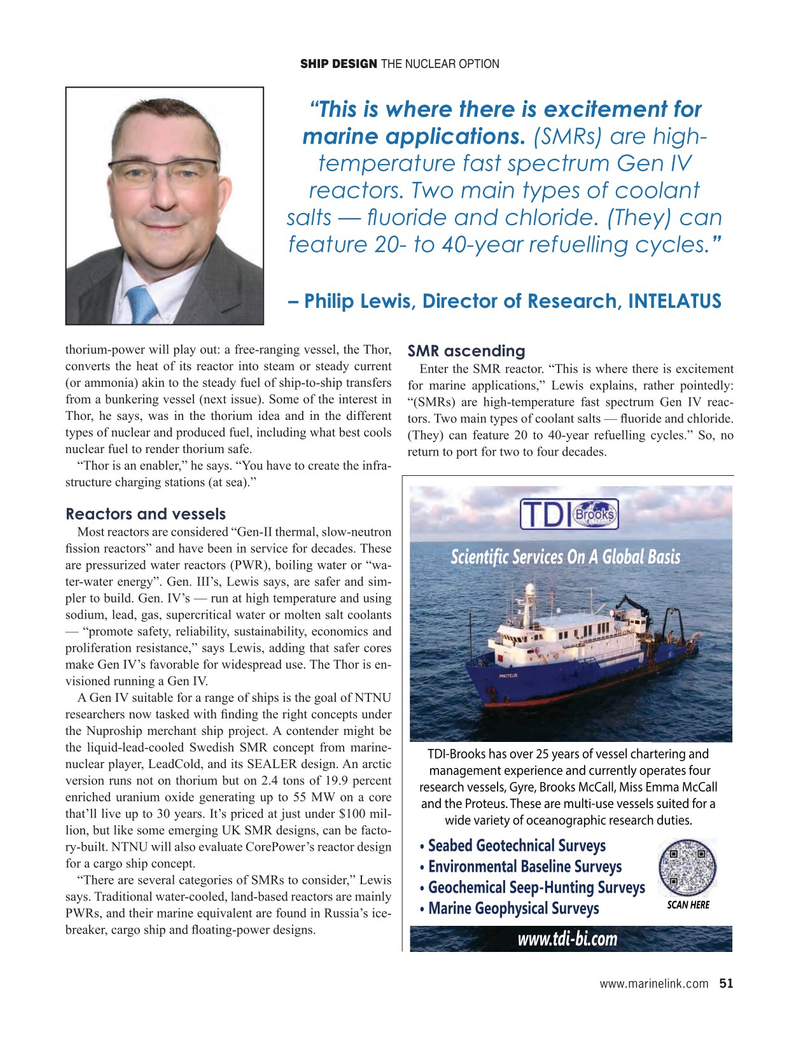
Page 51: of Maritime Reporter Magazine (September 2022)
The Marine Design Edition
Read this page in Pdf, Flash or Html5 edition of September 2022 Maritime Reporter Magazine
SHIP DESIGN THE NUCLEAR OPTION “This is where there is excitement for marine applications. (SMRs) are high- temperature fast spectrum Gen IV reactors. Two main types of coolant salts — ? uoride and chloride. (They) can feature 20- to 40-year refuelling cycles.” – Philip Lewis, Director of Research, INTELATUS thorium-power will play out: a free-ranging vessel, the Thor,
SMR ascending converts the heat of its reactor into steam or steady current
Enter the SMR reactor. “This is where there is excitement (or ammonia) akin to the steady fuel of ship-to-ship transfers for marine applications,” Lewis explains, rather pointedly: from a bunkering vessel (next issue). Some of the interest in “(SMRs) are high-temperature fast spectrum Gen IV reac-
Thor, he says, was in the thorium idea and in the different tors. Two main types of coolant salts — ? uoride and chloride. types of nuclear and produced fuel, including what best cools (They) can feature 20 to 40-year refuelling cycles.” So, no nuclear fuel to render thorium safe.
return to port for two to four decades.
“Thor is an enabler,” he says. “You have to create the infra- structure charging stations (at sea).”
Reactors and vessels
Most reactors are considered “Gen-II thermal, slow-neutron ? ssion reactors” and have been in service for decades. These
Scientific Services On A Global Basis are pressurized water reactors (PWR), boiling water or “wa- ter-water energy”. Gen. III’s, Lewis says, are safer and sim- pler to build. Gen. IV’s — run at high temperature and using sodium, lead, gas, supercritical water or molten salt coolants — “promote safety, reliability, sustainability, economics and proliferation resistance,” says Lewis, adding that safer cores make Gen IV’s favorable for widespread use. The Thor is en- visioned running a Gen IV.
A Gen IV suitable for a range of ships is the goal of NTNU researchers now tasked with ? nding the right concepts under the Nuproship merchant ship project. A contender might be the liquid-lead-cooled Swedish SMR concept from marine-
TDI-Brooks has over 25 years of vessel chartering and nuclear player, LeadCold, and its SEALER design. An arctic management experience and currently operates four version runs not on thorium but on 2.4 tons of 19.9 percent research vessels, Gyre, Brooks McCall, Miss Emma McCall enriched uranium oxide generating up to 55 MW on a core and the Proteus. These are multi-use vessels suited for a that’ll live up to 30 years. It’s priced at just under $100 mil- wide variety of oceanographic research duties. lion, but like some emerging UK SMR designs, can be facto- ry-built. NTNU will also evaluate CorePower’s reactor design • Seabed Geotechnical Surveys for a cargo ship concept.
• Environmental Baseline Surveys “There are several categories of SMRs to consider,” Lewis • Geochemical Seep-Hunting Surveys says. Traditional water-cooled, land-based reactors are mainly
SCAN HERE • Marine Geophysical Surveys
PWRs, and their marine equivalent are found in Russia’s ice- breaker, cargo ship and ? oating-power designs. www.tdi-bi.com www.marinelink.com 51
MR #9 (50-58).indd 51 9/5/2022 5:41:09 PM

 50
50

 52
52
